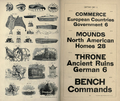Related Research Articles
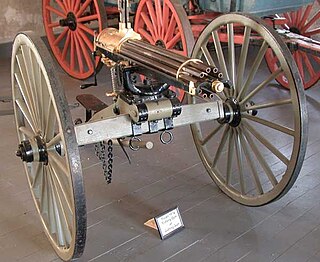
The Gatling gun is a rapid-firing multiple-barrel firearm invented in 1861 by Richard Jordan Gatling. It is an early machine gun and a forerunner of the modern electric motor-driven rotary cannon.

Richard Jordan Gatling was an American inventor best known for his invention of the Gatling gun, which is considered to be the first successful machine gun.

American Type Founders (ATF) Co. was a business trust created in 1892 by the merger of 23 type foundries, representing about 85 percent of all type manufactured in the United States at the time. The new company, consisting of a consolidation of firms from throughout the United States, was incorporated in New Jersey.

The Parrott rifle was a type of muzzle-loading rifled artillery weapon used extensively in the American Civil War.

Field artillery in the American Civil War refers to the artillery weapons, equipment, and practices used by the Artillery branch to support the infantry and cavalry forces in the field. It does not include siege artillery, use of artillery in fixed fortifications, or coastal or naval artillery. Nor does it include smaller, specialized artillery classified as small arms.
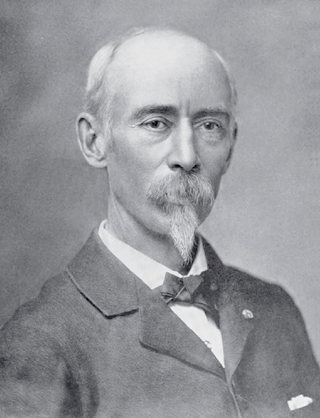
Andrew Hickenlooper was an Ohioan civil engineer, politician, industrialist, and a Union Army lieutenant colonel of artillery and engineers. In recognition of his service, in 1866, he was nominated and confirmed for appointment as a brevet brigadier general of volunteers to rank from March 13, 1865.
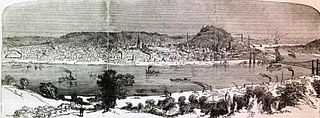
During the American Civil War, the Ohio River port city of Cincinnati, Ohio, played a key role as a major source of supplies and troops for the Union Army. It also served as the headquarters for much of the war for the Department of the Ohio, which was charged with the defense of the region, as well as directing the army's offensives into Kentucky and Tennessee.
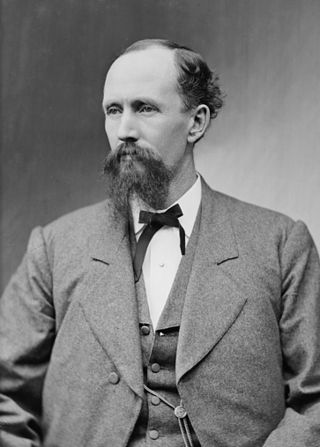
Ebenezer Byron Finley was an American attorney and politician from Ohio. A Democrat, he was most notable for his service as a U.S. Representative from 1877 to 1881.

Henry Martyn Cist was an American soldier, lawyer, and author who was a Union Army captain and staff officer during the American Civil War. On December 11, 1866 he was nominated and on February 6, 1867 he was confirmed for appointment to the grade of brevet brigadier general of volunteers, to rank from March 13, 1865. He is most noted for his classic and oft-referenced 1882 book The Army of the Cumberland. In addition, Cist led pioneering efforts to preserve and interpret the sites of the battles of Chickamauga and Chattanooga.

Pittsburgh, Pennsylvania, was a thriving and important city during the American Civil War, and provided a significant source of personnel, war materiel, armament, ammunition, and supplies to the Union Army. Situated at the confluence of the Monongahela, Allegheny and Ohio rivers, Pittsburgh was an important transportation hub for both riverine and rail transport, as well as overland via its system of roads.
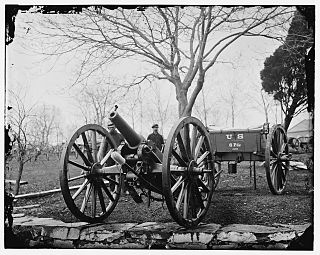
The Wiard rifle refers to several weapons invented by Norman Wiard, most commonly a semi-steel light artillery piece in six-pounder and twelve-pounder calibers. About 60 were manufactured between 1861 and 1862 during the American Civil War, at O'Donnell's Foundry, New York City: "although apparently excellent weapons, [they] do not seem to have been very popular". Wiard also designed a rifled steel version of the Dahlgren boat howitzer, among other gun types. Further, Wiard unsuccessfully attempted to develop a 15 in (381 mm) rifled gun for the US Navy and proposed a 20 in (510 mm) gun. In 1881 he unsuccessfully proposed various "combined rifle and smoothbore" weapon conversions of Rodman guns and Parrott rifles.
13th Ohio Battery was an artillery battery that served in the Union Army during the American Civil War.
The following list is a Bibliography of American Civil War Union military unit histories. More details on each book are available at WorldCat.
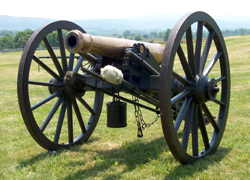
The M1841 6-pounder field gun was a bronze smoothbore muzzleloading cannon that was adopted by the United States Army in 1841 and used from the Mexican–American War to the American Civil War. It fired a 6.1 lb (2.8 kg) round shot up to a distance of 1,523 yd (1,393 m) at 5° elevation. It could also fire canister shot and spherical case shot (shrapnel). The cannon proved very effective when employed by light artillery units during the Mexican–American War. The cannon was used during the early years of the American Civil War, but it was soon outclassed by newer field guns such as the M1857 12-pounder Napoleon. In the U.S. Army, the 6-pounders were replaced as soon as more modern weapons became available and none were manufactured after 1862. However, the Confederate States Army continued to use the cannon for a longer period because the lesser industrial capacity of the South could not produce new guns as fast as the North.

The M1841 12-pounder field howitzer was a bronze smoothbore muzzle-loading artillery piece that was adopted by the United States Army in 1841 and employed during the Mexican–American War and the American Civil War. It fired a 8.9 lb (4.0 kg) shell up to a distance of 1,072 yd (980 m) at 5° elevation. It could also fire canister shot and spherical case shot. The howitzer proved effective when employed by light artillery units during the Mexican–American War. The howitzer was used throughout the American Civil War, but it was outclassed by the 12-pounder Napoleon which combined the functions of both field gun and howitzer. In the U.S. Army, the 12-pounder howitzers were replaced as soon as more modern weapons became available. Though none were manufactured after 1862, the weapon was not officially discarded by the U.S. Army until 1868. The Confederate States of America also manufactured and employed the howitzer during the American Civil War.

John Love was a United States Army officer during and after the Mexican-American War, a railroad contractor, an officer in the Union Army during the American Civil War and a major general in the Indiana Legion, also referred to as the Indiana militia or home guard or state defense force, during the American Civil War. After resigning on January 1, 1863, he was called back into service in July 1863 and commanded an Indiana militia force which pursued Confederate Brigadier General John Hunt Morgan's raiders in Indiana. On July 11, 1863, about 100 militia men held off Morgan's raiders at Vernon, Indiana, forcing them to withdraw when Love arrived with reinforcements arrived. After his service he was a real estate broker and representative of the Gatling Gun Company in Europe. In 1880, Congress appointed Love to be a manager of the National Home for Disabled Volunteer Soldiers.
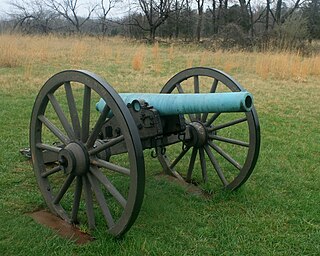
The 14-pounder James rifle or James rifled 6-pounder or 3.8-inch James rifle was a bronze muzzle-loading rifled cannon that was employed by the United States Army and the Confederate States Army during the American Civil War. It fired a 14 lb (6.4 kg) solid shot up to a distance of 1,530 yd (1,400 m) at 5° elevation. It could also fire canister shot and common shell. Shortly before the war broke out, the U.S. Army adopted a plan to convert M1841 6-pounder field guns from smoothbore to rifled artillery. Rifling the existing 6-pounders would both improve the gun's accuracy and increase the weight of the shell. There were two major types produced, both were bronze with a bore (caliber) of 3.8 in (97 mm) that would accommodate ammunition designed by Charles Tillinghast James. The first type looked exactly like an M1841 6-pounder field gun. The second type had a longer tube with a smooth exterior profile similar to a 3-inch Ordnance rifle. At first the rifles were quite accurate. However, it was discovered that the bronze rifling quickly wore out and accuracy declined. None of the rifles were manufactured after 1862, and many were withdrawn from service, though some artillery units employed the guns until the end of the war.

The M1841 24-pounder howitzer was a bronze smoothbore muzzle-loading artillery piece adopted by the United States Army in 1841 and employed from the Mexican–American War through the American Civil War. It fired a 18.4 lb (8.3 kg) shell to a distance of 1,322 yd (1,209 m) at 5° elevation. It could also fire canister shot and spherical case shot. The howitzer was designed to be employed in a mixed battery with 12-pounder field guns. By the time of the American Civil War, the 24-pounder howitzer was superseded by the 12-pounder Napoleon, which combined the functions of both field gun and howitzer. The 24-pounder howitzer's use as field artillery was limited during the conflict and production of the weapon in the North ended in 1863. The Confederate States of America manufactured a few 24-pounder howitzers and imported others from the Austrian Empire.

A repeating firearm or repeater is any firearm that is capable of being fired repeatedly before having to be manually reloaded with new ammunition into the firearm.
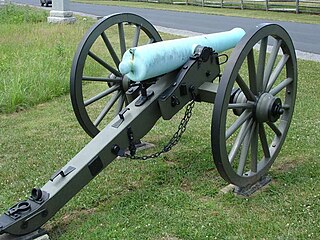
The M1857 12-pounder Napoleon or Light 12-pounder gun or 12-pounder gun-howitzer was a bronze smoothbore muzzleloading artillery piece that was adopted by the United States Army in 1857 and extensively employed in the American Civil War. The gun was the American-manufactured version of the French canon obusier de 12 which combined the functions of both field gun and howitzer. The weapon proved to be simple to produce, reliable, and robust. It fired a 12.03 lb (5.5 kg) round shot a distance of 1,619 to 1,680 yd at 5° elevation. It could also fire canister shot, common shell, and spherical case shot. The 12-pounder Napoleon outclassed and soon replaced the M1841 6-pounder field gun and the M1841 12-pounder howitzer in the U.S. Army, while replacement of these older weapons was slower in the Confederate States Army. A total of 1,157 were produced for the U.S. Army, all but a few in the period 1861–1863. The Confederate States of America utilized captured U.S. 12-pounder Napoleons and also manufactured about 500 during the war. The weapon was named after Napoleon III of France who helped develop the weapon.
References
- ↑ "O. & H. Wells bought the establishment ..." ("Cincinnati Type Foundry," Ohio State Journal And Columbus Gazette; Date: 07-06-1826")
- ↑ Cornell, Alice M. (2001). Art as Image: Prints and Promotion in Cincinnati, Ohio. Ohio University Press. pp. 5. ISBN 0-8214-1335-X.
- ↑ Carpenter, E. H. (1956). Army Field Printing in the New World. The Papers of the Bibliographical Society of America, 50(2), 169–180.
- 1 2 Boudreau, J. (2012). The Portable Press and Field Printing during the American Civil War. Printing History, (12), 3+.
- ↑ Marcot, R. M. (1862). The Development of The Gatling Gun.
